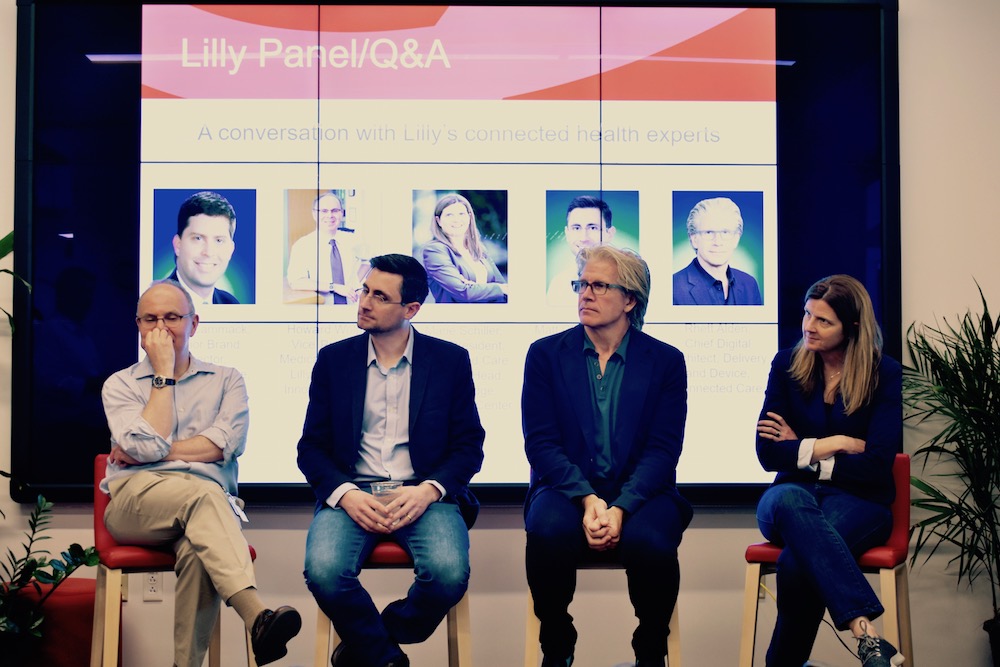First Look at Lilly’s Automated Insulin Delivery System
By Jeemin Kwon
 By Jeemin Kwon and Brian Levine
By Jeemin Kwon and Brian Levine
At the Lilly Diabetes Bloggers Summit, diaTribe got to hold a prototype of Lilly’s new, disk-like pump, which will integrate with Dexcom G6 CGM in a hybrid-closed loop system
Want more news like this?
diaTribe was invited to visit the Lilly Innovation Center in Cambridge to witness the very first public reveal of their automated insulin delivery (AID) system prototype. (For those who are new to diabetes technology, click here for an overview.) From our initial coverage of the system in November 2017, we knew that the system will consist of a custom disk-shaped pump, a Dexcom continuous glucose monitor (today, we learned this would be the new G6!), and an algorithm that adjusts basal insulin delivery every five minutes to keep glucose in range. The system is expected to launch in 2-3 years. At day one of this meeting, Lilly revealed more specifics about their custom pump and paired controller/smartphone app:
The pump:
-
The white, disk-shaped pump is about the size of a shuffleboard puck (about two inches across), with a fairly flat profile (about half an inch thick)
-
The pump does not have any screen or a user interface – it is controlled wirelessly from a handheld or a phone (see below). There is a single button on the device used for administering mealtime insulin (boluses)
-
Lilly's pump has tubing, but will allow for flexible wear – it can be worn as a patch (pump fixed on body) with a short infusion set, or slipped into a pocket/waistband with a longer infusion set.
-
The pump reservoir (insulin container) holds a maximum of 300 units of insulin – about three days’ worth. It will have a manual fill option, but Lilly is also working on prefilled reservoirs.
-
The hybrid closed loop control algorithm is housed in the pump, which also talks directly to the Dexcom G6 CGM. This means a user will remain in hybrid closed loop even when the handheld is out of range – e.g., while running.
-
The pump is separated into two parts: the bottom half holds the disposable reservoir (replaced every three days), while the reusable top half holds a rechargeable battery and the algorithm.
The wireless handheld/app controller:
-
Lilly is developing two ways of communicating to the pump: a smartphone-like handheld and apps for iOS and Android phones. The handheld will almost certainly be available at launch, while Lilly will have to work with the US FDA on whether users can talk to the pump from their phone, enter carbs, etc.
-
Lilly is working closely with Dexcom to carry over the best features of the Dexcom G5/G6 mobile app. The prototype app interface strongly resembled Dexcom’s current one. A user will be able to get all of the information available in Dexcom’s app through Lilly’s.
Unfortunately, photography was not allowed during this presentation.
In this moment, it is still too early to tell what programs and policies will be put into place to make this technology accessible to more people.
Stay tuned for more info about the dosing algorithm from day two!
What is an insulin pump?
Insulin pumps are devices that deliver insulin without the need for manual injections. In addition to the insulin itself, typical tubed insulin pumps (e.g., Medtronic, Roche, Tandem) require three main components (all of which are connected to the body):
-
Pump
-
Inserted sub-cutaneous (beneath the skin) cannula – delivers insulin
-
Tubing – delivers insulin from the pump to the cannula
Insulet's Omnipod is a tubeless pump that does not have an infusion set.
What is a CGM?
Continuous glucose monitors (CGMs) monitor the body’s glucose levels in real-time by sensing the glucose present in tissue fluid (also called interstitial fluid). CGMs require three basic parts:
-
Sensor – monitors glucose levels, inserted under the skin of the abdomen or arm
-
Transmitter – sends glucose information to the receiver, attached to body
-
Receiver – displays glucose level trends. For some products (e.g. Dexcom CGM), the patient carries the receiver (which is not attached to the body). For others (e.g. Medtronic Paradigm/MiniMed CGMs), the CGM is combined with an insulin pump
Abbott's FreeStyle Libre is a different type of continuous glucose monitor, as it does not transmit glucose data automatically; a user must scan a handheld or app over the sensor to obtain a reading.
What is automated insulin delivery?
Automated insulin delivery, or AID, seeks to use CGM and smart algorithms to decide how much insulin to deliver via pump. Also known as an artificial pancreas, AID’s end goal is to remove user input from insulin dosing, reduce hypoglycemia, and improve time in target range. For more info on AID systems in development, click here.
What is a hybrid closed loop?
Hybrid closed loop refers to a type of automated insulin delivery that automates much of insulin therapy, but not all. In this case, basal (background) insulin dosing is controlled by the algorithm, but mealtime insulin dosing (boluses) are still done manually by the user. More automated systems are commonly referred to as “fully closed loop” systems.
Disclosure: Lilly Diabetes paid for diaTribe’s travel and lodging expenses







